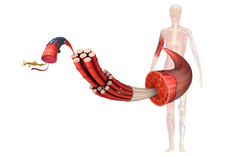How To Build Muscle With Calisthenics (Everything You Need To Know)
Are you looking to build muscle but don't want to spend hours at the gym or money on expensive equipment? Calisthenics might be the answer for you. In this blog post, we'll cover everything you need to know about how to build muscle with calisthenics, including the science behind muscle growth, the best exercises and workouts to try, and tips for creating your own training program. We'll also discuss how often you should train, how to avoid getting stuck in a rut with your workouts, and how long it typically takes to build muscle with calisthenics. Plus, we'll address some common mistakes people make when trying to gain muscle with calisthenics and offer some options for those with busy schedules. Finally, we'll touch on the many health benefits of gaining muscle through calisthenics. Whether you're just starting out with calisthenics or are an experienced athlete looking to add some variety to your training, this post has something for you.

Yes, You Can Build Muscle with Calisthenics Bodyweight Exercises
Calisthenics might seem like it is only for people who want to keep their bodies fit, but the truth is that it is also an excellent way to build muscle. This type of strength training relies on the progressive overload principle. Unlike lifting weights, with Calisthenics you can make exercises more difficult by adapting them instead of adding extra weight. For instance, if a person starts out doing push-ups from their knees, they can move up to full push-ups and then finish with archer push-ups in gymnastic rings to really challenge those muscles and build mass. With consistency and determination, calisthenics can give a person significant results in terms of building muscle.
The Science of Building Muscle Mass
Building muscle mass involves increasing the size and strength of your muscles through a process called muscle hypertrophy. When you lift weights or perform other resistance exercises, you create small tears in your muscle fibers. Your body then repairs these tears, and in the process, the muscle fibers grow bigger and stronger. This process is aided by the release of hormones like testosterone and growth hormone, which help stimulate muscle growth. To build muscle mass, it's important to consistently challenge your muscles with progressively heavier weights or increased resistance. It's also significant to get enough protein, as it's the building block of muscle tissue. Additionally, getting enough rest and sleep is crucial, as this is when your body repairs and rebuilds muscle tissue.

The Diversity of Calisthenics: Disciplines and Goals
The term Calisthenics refers to a versatile training method that encompasses various disciplines, such as Weighted Calisthenics, Freestyle Calisthenics, Bodyweight Calisthenics, and Ring Training. Each of these styles has its own goals, requirements, and often specific equipment needed for optimal training. At the same time, there are overlaps that allow you to combine elements from multiple areas seamlessly.
Which Type of Calisthenics is Best for Muscle Gain?
When it comes to building muscle, not all disciplines are equally effective. Some are specifically designed to maximize strength and hypertrophy, while others focus more on mobility, control, or skill development. Understanding the strengths of each discipline can help you decide which approach best aligns with your muscle-building goals.

Is Bodyweight Calisthenics Effective for Muscle Growth?
Body weight Calisthenics including basic exercises like pull-ups, chin-ups, dips, and push-ups, as well as static elements and skills like planche, front lever, and human flag. Basic calisthenic exercises are good for building muscle, but static elements and skills may not be as effective. These calisthenics movements require a lot of body awareness and involve your core muscles but are missing concentric and slow eccentric movements. These movements are necessary for every strength training exercise to ensure a full range of motion, which is one key factor for muscle building.

Ring Training: A Powerful Tool for Muscle Growth?
Ring training, which involves working out exclusively with gymnastic rings, is an excellent approach for muscle gain. Most exercises performed on gymnastic rings are compound movements that engage multiple muscle groups simultaneously, making them incredibly effective for building overall upper-body strength and size.
One of the greatest advantages of ring training is its adaptability. The rings allow you to adjust the difficulty of exercises to match your fitness level. You can tailor the intensity of each exercise to create the ideal stimulus for hypertrophy or strength development. By simply changing your body angle, exercise progression or leverage, you can ensure that your workouts remain challenging and productive.

Supercharge Your Strength with Weighted Calisthenics
Weighted Calisthenics involves adding resistance, such as weights, to calisthenics exercises like weighted pull-ups, weighted dips, and weighted ring rows. It can also include movements with barbells that complement your bodyweight training. This approach is incredibly effective for building muscle, as the added resistance increases the intensity of each exercise, creating the necessary stimulus for hypertrophy.
One of the standout benefits of Weighted Calisthenics is its ability to introduce new progression steps after you've built a foundation with Bodyweight Calisthenics or Ring Training. Once bodyweight exercises no longer challenge you, adding weight allows you to continue progressing and building strength. By gradually increasing the resistance, you can maintain consistent overload, a key factor for muscle growth and strength development.
Should You Choose Freestyle Calisthenics for Maximum Hypertrophy?
Freestyle combines elements of strength, technique, and courage, is popular among athletes who specialize in this dynamic discipline. While it may not be as effective as traditional resistance or weight training for building muscle, freestyle calisthenics can be a fun and challenging way to improve overall fitness. Many freestyle skills do not isolate specific muscle groups and are performed with momentum, incorporating elements of acrobatics and gymnastics. As a result, they may not be as effective for muscle gain compared to exercises that are designed specifically for resistance training. However, freestyle calisthenics can still provide a full-body workout and offer numerous other physical and mental benefits.

Dive into Ring Training, Calisthenics or Weighted Calisthenics - The Choice is Yours!
Explore your potential with the DIE RINGE App, meticulously crafted to align with your fitness aspirations.
How to Create Your Own Calisthenics Training Program
Designing a personalized calisthenics training program can feel overwhelming at first, but with the right steps, you can build a routine tailored to your goals and fitness level. Here’s a simple guide to help you create your ideal program:
1. Define Your Calisthenics Goals: What Do You Want to Achieve?
Start by identifying your primary objectives. Are you aiming to build muscle, enhance strength, improve mobility, or boost overall fitness? Clear goals will guide your exercise selection, workout structure, and progression plan. For example:
For muscle building: Focus on exercises that stimulate muscle growth, such as pull-ups, dips, and push-ups. Train in a repetition range of 6–20 reps per set, depending on the intensity of the exercise. Adjust the difficulty to ensure that you approach muscle fatigue within this range.
For strength gains: Incorporate exercises designed to build maximum strength, such as heavy chin-ups, weighted dips, or pistol squats. Aim for movements that bring you close to muscle failure within 1–6 repetitions. Using additional resistance, such as weights or bands, is often helpful in achieving the necessary intensity.
For general fitness: Focus on a balanced program that combines strength, mobility, and endurance exercises. This approach promotes overall health and functional fitness, ensuring your body is capable of a wide range of activities.
2. Select the Right Calisthenics Exercises
Choose exercises that align with your goals and fitness level. Keep variety in mind to target different muscle groups and prevent plateaus. Some examples include:
- Upper body: Pull-ups, Dips, Push-ups, Ring Rows.
- Lower body: Squats, Lunges, Step-ups, Hip Thrusts.
- Core: Plank Variations, Leg Raises, Hollow Body Holds.
Adapt each exercise based on your ability and your specific training goals. For example, beginners can modify push-ups by performing them on their knees, while advanced athletes might opt for one-arm push-ups. Ensure that you adjust the difficulty of each exercise so you can perform the number of repetitions that aligns with your goal.
3. Structure Your Calisthenics Workouts
Frequency: Decide how many days per week you’ll train. For beginners, 2–3 sessions per week might be ideal, while advanced athletes can train 4–6 days. Be sure to include at least one rest day after each training session to allow your muscles to recover and grow effectively.
Duration: Aim for 30–60 minutes per workout, depending on your availability and intensity level.
Sets and Reps: Tailor these to your goals:
- For strength gains, focus on fewer reps with higher difficulty, aiming for 1–6 repetitions per set.
- For muscle building (hypertrophy), train in a range of 6–20 repetitions per set, ensuring the intensity is high enough to reach near muscle fatigue.
- Perform 2–3 sets per exercise, which is sufficient to stimulate muscle growth and strength development without overtraining.
Consider starting with a full-body workout that includes upper-body, lower-body, and core exercises. As you progress, you can switch to split routines (e.g., upper/lower or push/pull splits) to target specific muscle groups more intensively.
4. Track and Adjust Your Progress
Monitoring your progress is essential to staying motivated and ensuring consistent improvement. Record details like:
- The exercises performed.
- The number of sets and reps completed.
- Any added resistance (e.g., weighted calisthenics).
Regularly evaluate your performance and make adjustments, such as increasing difficulty or adding new exercises, to keep challenging your body.

How Many Sessions a Week for Muscle Growth?
The frequency of your strength training sessions depends on your fitness level and goals. For effective muscle growth with calisthenics, it’s generally recommended to train each muscle group 1–3 times per week. This frequency provides enough stimulation for growth while allowing adequate recovery time between workouts to prevent overtraining. Progressive overload—gradually increasing the difficulty of your exercises—is crucial for building muscle over time.
If you’re a beginner or new to calisthenics, starting with 1–2 sessions per week can be more manageable. As your strength improves and your body adapts, you can gradually increase your training frequency to maximize results.
Remember to include rest days between workouts, as this is when muscles repair and grow stronger. Without proper recovery, you risk stalling progress and increasing the likelihood of injury.
Ultimately, it’s essential to listen to your body and adjust your training schedule based on how you feel. Rest when needed, push harder when you’re ready, and maintain consistency for optimal results.
How to Avoid Plateaus with Progressive Overload
To continue making gains in calisthenics and avoid getting stuck in a rut with your strength training, it's important to regularly challenge your muscles with progressively harder workouts. One way to do this is to use the principle of progressive overload, which involves gradually increasing the intensity or volume of your workouts over time.
This can be achieved by adding more reps or sets, increasing the weight you use, or decreasing the rest periods between sets. It's also essential to vary your workouts by trying new exercises and incorporating different training techniques, such as supersets, drop sets, and forced reps. Additionally, it's critical to pay attention to your nutrition and ensure that you are getting enough protein and other nutrients to support muscle growth. Finally, be sure to get enough rest and recovery time between workouts to allow your muscles to repair and rebuild themselves. By following these strategies, you can continue to make gains in calisthenics and avoid getting stuck in a plateau.
How Long Does It Take to Build Muscle with Calisthenics?
Building muscle with calisthenics, like any form of strength training, requires time, consistency, and dedication. How quickly you see results depends on several factors, including:
- Your Starting Fitness Level: Beginners often experience faster initial progress, as their muscles adapt to the new stimulus.
- Genetics: Factors such as muscle fiber composition and metabolism can influence how quickly you gain muscle.
- Diet and Nutrition: Adequate protein intake and a balanced diet are critical for muscle recovery and growth.
- Training Intensity and Frequency: Consistent, progressive overload is key to stimulating muscle hypertrophy.
What to Expect
- Short-Term: Within a few weeks, you might notice improvements in strength, endurance, and muscle definition as your body adapts to the exercises.
- Mid-Term: Over the course of 2–3 months, with consistent training and proper nutrition, visible muscle growth becomes more evident. Beginners may see more dramatic changes during this period.
- Long-Term: Significant muscle growth typically requires 6 months or more, especially for those with prior training experience or more advanced fitness levels.
Tips for Success
- Be Patient: Muscle growth is a gradual process. Avoid expecting overnight transformations, and instead focus on steady progress.
- Celebrate Your Progress: Recognize small victories, like mastering a new exercise or completing more reps. This helps maintain motivation.
- Avoid Comparisons: Everyone’s journey is unique, and progress can vary based on individual factors. Focus on your own improvement rather than comparing yourself to others.
With consistent effort, progressive overload, and proper nutrition, you’ll see meaningful muscle gains over time. Remember, building muscle is as much about the process as it is about the results.
Mistakes Most Guys Make Trying to Gain Muscle with Calisthenics
Building muscle with calisthenics is entirely achievable, but it requires the right approach. Many people fall into common traps that can hinder their progress. Here's a closer look at these mistakes and how to avoid them:
1. Lack of Training Intensity and Volume
One of the most common mistakes is not training with enough intensity or volume. To build muscle, your workouts must progressively challenge your muscles. This means gradually increasing the difficulty by:
- Adding more reps or sets.
- Incorporating weighted calisthenics for additional resistance.
- Decreasing rest periods between sets to increase workout density.
Without progressively overloading your muscles, you’ll plateau and miss out on growth opportunities.
2. Inadequate Recovery Time
Another frequent misstep is not allowing sufficient recovery between workouts. Strength training causes micro-tears in your muscles, and these need time to repair and grow stronger. Without adequate rest, you risk overtraining, which can lead to stagnation or even muscle loss. Include rest days and prioritize quality sleep to maximize recovery.
3. Poor Nutrition, Especially Protein Intake
Muscle growth isn’t just about what you do in the gym; it also depends on how well you fuel your body. A lack of protein and other nutrients can stall your progress. To support muscle recovery and growth:
- Consume a diet rich in lean protein sources like chicken, fish, eggs, or plant-based alternatives.
- Incorporate carbs and healthy fats to fuel your workouts and overall energy needs.
- Prioritize post-workout nutrition to kickstart the recovery process.
4. Inconsistency and Impatience
Building muscle takes time and dedication, yet many people give up too soon or fail to stick with a program long enough to see results. Jumping between routines or skipping workouts undermines your progress. To succeed:
- Commit to a structured training program and track your progress over weeks and months.
- Stay patient and focus on long-term consistency rather than expecting instant results.
By addressing these common mistakes, you’ll set yourself up for success and make steady gains in muscle size and strength with calisthenics.
Conclusion: Does Calisthenics Build Muscle?
Calisthenics offers a powerful and accessible way to build muscle, increase strength, and improve overall fitness. By using your own body weight as resistance, you can engage multiple muscle groups simultaneously and develop a lean, muscular physique.
Bodyweight exercises like Chin-ups, Dips, Push-ups, Rows, and Squats not only target specific muscle groups but also train essential movement patterns that enhance functional strength. To maximize muscle growth, focus on progressive overload, proper form, and technique. Consistently challenging your muscles is key to achieving noticeable results.
Incorporating additional elements such as ring training and weighted calisthenics can further intensify your workouts and unlock new levels of strength and muscle development. These variations provide additional progression steps and variety, ensuring your routine stays effective and engaging.
By following a structured training program and staying consistent, you can achieve a strong, athletic physique while mastering the control of your own body. Calisthenics isn’t just a workout—it’s a journey to strength and self-mastery.
No Time to Create a Workout Plan? Let the DIE RINGE App Do It for You
If you’re pressed for time or unsure where to begin with your calisthenics journey, the DIE RINGE App is a game-changer. This app simplifies the process by creating a custom workout plan tailored to your fitness goals and the skills you want to develop.
Key Features of the DIE RINGE App
Whether you’re just starting or looking to add variety to your routine, the DIE RINGE App provides everything you need to stay consistent and achieve your goals. Take the guesswork out of planning and focus on what matters most: progressing in your training and enjoying the process.

Personalized Workout Plans
Based on your preferences and objectives, the app generates a plan designed to help you build strength, master calisthenics skills, or improve overall fitness.
Skill Progressions and Instructional Videos
Learn new movements step-by-step with detailed instructional videos, perfect for beginners and advanced athletes alike.
Progress Tracking
Stay motivated by monitoring your improvements over time, whether it’s mastering a pull-up or progressing to more advanced exercises.

Personalized Workout Plans
Based on your preferences and objectives, the app generates a plan designed to help you build strength, master calisthenics skills, or improve overall fitness.

Skill Progressions and Instructional Videos
Learn new movements step-by-step with detailed instructional videos, perfect for beginners and advanced athletes alike.

Progress Tracking
Stay motivated by monitoring your improvements over time, whether it’s mastering a pull-up or progressing to more advanced exercises.